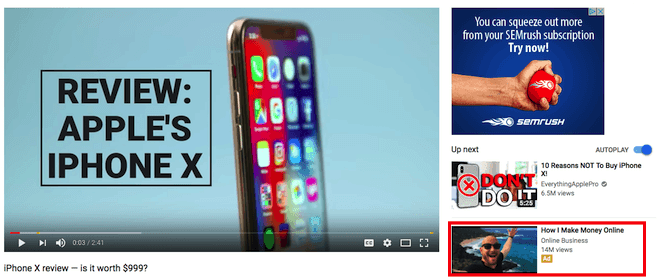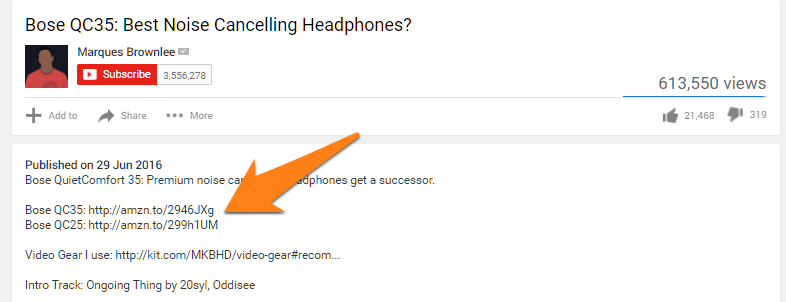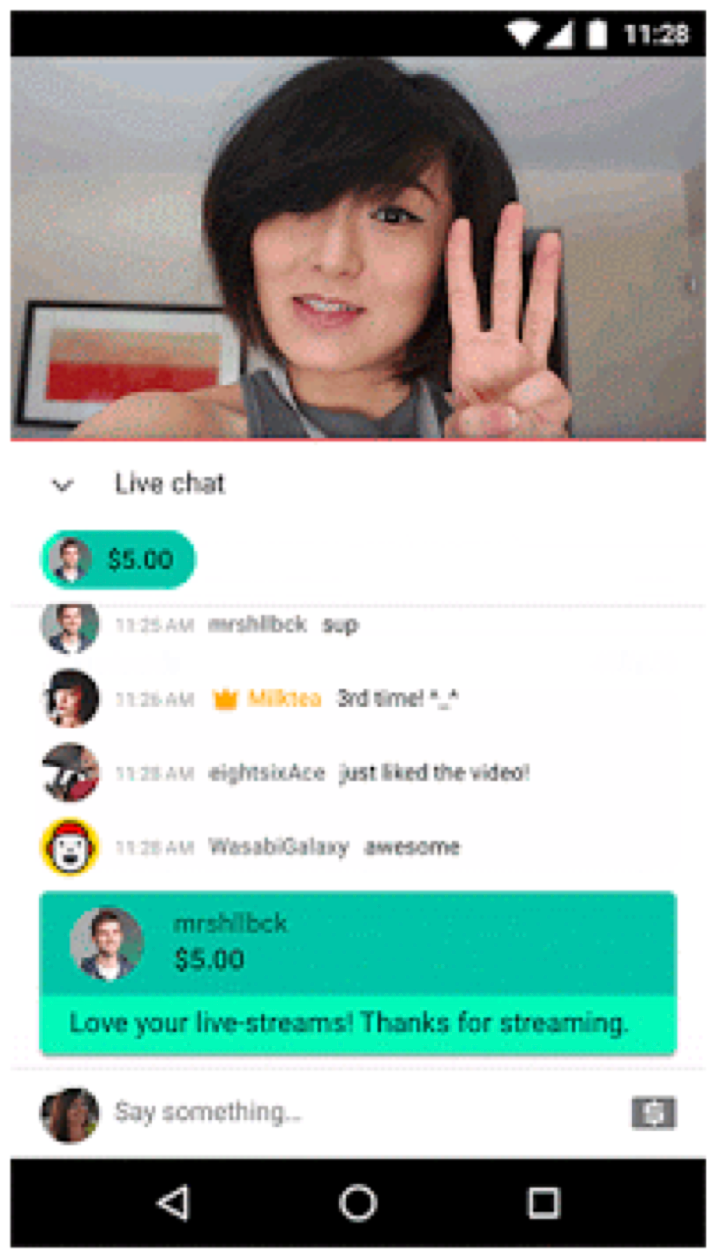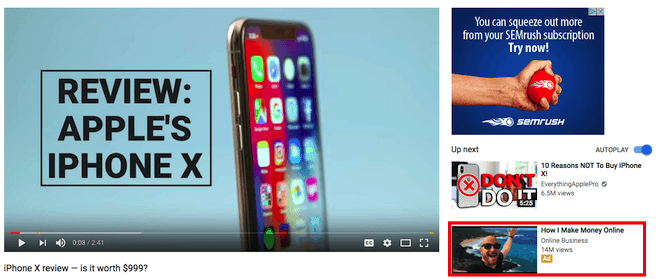Discovery ads appear on the right sidebar of a selected video, just below the “Up Next” video as a suggested result. See how this one looks below.

Because of the time you’re allotted with this ad format, it’s suggested that you create this type of ad with the goal of views and brand development, rather than just clicks into your website. This ad ideally generates revenue from the long-term brand awareness that comes out of a story people don’t want to skip, and one viewers remember the next time they approach your product or service.
Both In-Stream and Discovery are pay-per-view — you pay YouTube a fixed rate for every view the ad receives — and their return on investment (ROI) can be measured in Google AdWords. YouTube tallies one new “view” after 30 seconds of watching, or a click on the video as it’s playing. If the video is less than 30 seconds, views are tallied from people who watch the entire ad.
We’ll explain how AdWords manages all three ad formats in a minute.
Preroll
Like In-Stream ads, Preroll ads play in the stream immediately before a user’s selected video. The difference is this ad type can’t be skipped after five seconds. These videos also run a maximum of 30 seconds, though YouTube recently confirmed it will limit advertisers to 15- and 20-second options starting this year.
Because viewing is required in this ad format, advertisers pay per click, so make the click worth it. A preroll ad with an enticing call-to-action that directs viewers to an appropriate landing or purchasing page on your website can be an enormous lead-generator for the sales team.
You can also leverage YouTube’s remarketing options, which enable you to send new videos back to users who’ve already engaged with your YouTube channel. If you’re a HubSpot user, and you’ve built smart forms for capturing new information on returning visitors, remarketing can be a terrific addition to an inbound marketing campaign.
This remarketing option helps you learn more about a person’s background and interests when they receive new videos that bring them to new landing pages.
Bumpers
Bumpers are the shortest ads you can buy. These six-second spots play just before a viewer’s selected video (like the above two options) but are best for brand awareness in the short breaks between long videos, or a YouTube playlist a user might be listening to in the background.
While they might be brief, YouTube found 90% of their bumper ads were remembered later by viewers. Bumpers are sold through cost-per-minute (CPM) bidding, which means you pay for every 1,000 plays of your ad on YouTube. They’re best used as a compliment to a TrueView ad campaign.
So how do you track the performance of these three video ad formats? Once you’ve created a YouTube channel and uploaded your video content, you can open a Google AdWords account and link it to your video campaign. In AdWords, select the campaign type, ad format, your budget, and to whom and where to show each video on YouTube.
You can target very specific audiences, and track the conversion rate of each video individually to see how much business (and revenue) you’re driving. See this blog post to learn more about this process.
2. Be an Advertising Platform
If advertising is a marathon, the next two strategies are a sprint … sort of. When you think about how to make money on YouTube, you’re probably thinking of the following options. In this case, you’re the one getting paid to host others’ advertisements — the other side of the YouTube advertising relationship.
Keep in mind that while turning your videos into ad space can make money more quickly and directly, it requires more heavy lifting on your part to make a decent profit.
Here are your main options:
YouTube Partner Program
The YouTube Partner Program (YPP) allows the website’s most successful YouTube channels to monetize their content by serving ads made and paid for by other YouTube users.
The criteria for this program — which changed in 2018 — requires that your channel has reached 4,000 watch hours and 1,000 channel subscribers in the last 12 months. Once you have passed these two milestones, you can apply to join the program through the following steps:
- At the top-right of the YouTube homepage, click your account icon and select “Creator Studio.”
- On the left-hand side, click “Channel” and select “Status and features.”
- Under the box, “Monetization,” click “Enable.” Don’t be fooled if it says you’re already “Eligible” to the left; this just indicates there are no restrictions against you from trying to become a Partner.
- You’ll be asked to agree to the YPP Terms. Do so, and you’ll then sign up for an AdSense account so you can receive revenue through your monetized YouTube account.
- Set your ad hosting preferences and follow the prompts to submit your channel for review.
YouTube typically emails you a decision on whether they’ve accepted you into the YPP within a week of applying, so sit tight. Still trying to hit the right watch hours and channel subscribers? Keep in mind you should be posting prolifically — having just one or two videos on your channel that you’re personally proud of won’t cut it.
By publishing multiple videos a week, you can build your viewership, qualify for YPP, and make decent cash. YouTube splits ad revenue 55-45 with its partners — 45% to Google, 55% to you. That means an advertiser who invests $200 in serving ads on your channel can bring you $110 for your videos’ real estate.
Affiliate Links
As an affiliate, there is no eligibility requirement — you’re taking advertising into your own hands. This is a great option for YouTube channels that offer reviews and how-to’s, and frequently recommend new products to its viewers.
Turn those suggestions into paid (but natural) product placements in the description section of your video, as shown below:
 Image via Authority Hacker
Image via Authority Hacker
Working as an affiliate of various brands can make you money — albeit usually less than a YouTube Partner campaign — each time that company makes a sale off a link you post on one of your videos. In this case, you’re earning revenue from the company of which you are an affiliate, rather than from YouTube and its advertisers.
Start by joining an affiliate network through sites like Click Bank or Amazon’s Affiliate Program, and follow the signup instructions. Keep in mind that each program takes a different percentage of a sale as commission, and your success is still tied to the popularity of your YouTube channel.
Bonus: Fan-Fund Your YouTube Channel
What exactly is fan-funding? It’s exactly what it sounds like: viewers donate money to your channel if they find your content enjoyable.
It’s the perfect option for videos managed by charities and nonprofits, but even for-profit businesses and independent creatives can publish videos and YouTube Live streams that encourage contributions from their audience. Streaming platforms such as Twitch.tv, which webcasts video games and general interest content, sees accounts that are two years or older make $80 in “tips” per year on average.
Twitch.tv’s most popular users make thousands.
Obviously YouTube and Twitch have different users, but YouTube has just as many loyal channel subscribers who would likely pay for exclusive rewards and content. On YouTube, sign up for Fan Funding to allow viewers of a live stream to tip through a chat window associated with the video.
YouTube calls them Super Chats, shown on a mobile device below:

You can also sign up for Patreon, which allows you to launch membership-only video channels through YouTube at a small fee per month for regular rewards. Just imagine how much a YouTube channel could generate if it has the 1,000 subscribers required by the YPP. Charge $1 for a new channel with new content, and you could be looking at a solid monthly revenue stream.
There’s no shortcut to well-earned cash money, even on YouTube. The good news is video is taking up an increasingly wide slice of global internet bandwidth, and there are numerous ways to produce video content that’s good enough for people to pay for.


